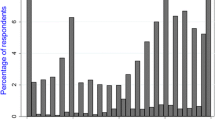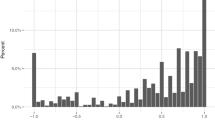Abstract
Background
The second version of the Short-Form 6-Dimension (SF-6Dv2) classification system has recently been developed. The objective of this study was to develop a value set for SF-6Dv2 based on the societal preferences of a general population in the capital of Iran.
Methods
A representative sample of the capital of Iran (n = 3061) was recruited using a stratified multistage quota sampling technique. Face-to-face interviews were conducted using binary choice sets from the international valuation protocol of the discrete choice experiment with duration. The conditional logit was used to estimate the final value set, and a latent class model was employed to assess heterogeneity of preferences.
Results
Coefficients generated from the models were logically consistent and significant. The best model was the one that included an additional interaction term for cases where one or more dimensions reached their most severe levels. It provides a value set with logical consistent coefficients and the lowest percentage of worse than death health states. Predicted values for the SF-6Dv2 were within the range of − 0.796–1. Pain dimension had the largest impact on utility decrement, whereas vitality had the least impact. The presence of preference heterogeneity was evident, and the Bayesian Information Criterion indicated the optimal fit for a latent class model with two classes.
Conclusion
This study provided the SF-6Dv2 value set for application in the context of Iran. This value set will facilitate the use of the SF-6Dv2 instrument in health economic evaluations and clinical settings.

Similar content being viewed by others
Data availability
Available on a reasonable request from the corresponding author.
References
Bank, W. (2023). https://data.worldbank.org/indicator/SH.XPD.CHEX.GD.ZS?locations=IR.
Afshari, S., Daroudi, R., Goudarzi, R., Mahboub-Ahari, A., Yaseri, M., Sari, A. A., Ameri, H., Bahariniya, S., Oliaei-Manesh, A., & Kalavani, K. (2023). A national survey of Iranian general population to estimate a value set for the EQ-5D-5L. Quality of Life Research, 32, 2079–2087.
Weinstein, M. C., Torrance, G., & McGuire, A. (2009). QALYs: The basics. Value in Health., 12, S5–S9.
Kennedy-Martin, M., Slaap, B., Herdman, M., van Reenen, M., Kennedy-Martin, T., Greiner, W., Busschbach, J., & Boye, K. S. (2020). Which multi-attribute utility instruments are recommended for use in cost-utility analysis? A review of national health technology assessment (HTA) guidelines. The European Journal of Health Economics, 21, 1245–1257.
Devlin, N., Parkin, D., & Janssen, B. (2020). Methods for analysing and reporting EQ-5D data. Springer Nature.
Goudarzi, R., Sari, A. A., Zeraati, H., Rashidian, A., Mohammad, K., & Amini, S. (2019). Valuation of quality weights for EuroQol 5-dimensional health states with the time trade-off method in the capital of Iran. Value in Health Regional Issues, 18, 170–175.
Ameri, H., Safari, H., & Poder, T. (2021). Exploring the consistency of the SF-6Dv2 in a breast cancer population. Expert Review of Pharmacoeconomics & Outcomes Research, 21(5), 1017–1024.
Nahvijou, A., Safari, H., & Ameri, H. (2020). Comparing the performance of the EQ-5D-5L with two versions of the SF-6Dv2 in patients with breast cancer. Health Services and Outcomes Research Methodology, 20, 183–194.
Nahvijou, A., Safari, H., & Ameri, H. (2021). Psychometric properties of the SF-6Dv2 in an Iranian breast cancer population. Breast Cancer, 28, 937–943.
Nahvijou, A., Safari, H., Yousefi, M., Rajabi, M., Arab-Zozani, M., & Ameri, H. (2021). Mapping the cancer-specific FACT-B onto the generic SF-6Dv2. Breast Cancer, 28, 130–136.
Yousefi, M., Nahvijou, A., Sari, A. A., & Ameri, H. (2021). Mapping QLQ-C30 onto EQ-5D-5L and SF-6D-V2 in patients with colorectal and breast cancer from a developing country. Value in Health Regional Issues, 24, 57–66.
Xie, S., Wang, D., Wu, J., Liu, C., & Jiang, W. (2022). Comparison of the measurement properties of SF-6Dv2 and EQ-5D-5L in a Chinese population health survey. Health and Quality of Life Outcomes, 20(1), 1–13.
Xie, S., Wu, J., & Chen, G. (2023). Comparative performance and mapping algorithms between EQ-5D-5L and SF-6Dv2 among the Chinese general population. The European Journal of Health Economics, 25, 7–19.
Brazier, J., Roberts, J., & Deverill, M. (2002). The estimation of a preference-based measure of health from the SF-36. Journal of health economics., 21(2), 271–292.
Brazier, J. E., & Roberts, J. (2004). The estimation of a preference-based measure of health from the SF-12. Medical Care, 42, 851–859.
Brazier, J. E., Mulhern, B. J., Bjorner, J. B., Gandek, B., Rowen, D., Alonso, J., Vilagut, G., & Ware, J. E. (2020). Developing a new version of the SF-6D health state classification system from the SF-36v2: SF-6Dv2. Medical Care, 58(6), 557–565.
Wang, L., & Poder, T. G. (2023). A systematic review of SF-6D health state valuation studies. Journal of Medical Economics, 26(1), 584–593.
Whitehurst, D. G., Brazier, J. E., Viney, R., & Mulhern, B. J. (2020). The SF-6Dv2: How does the new classification system impact the distribution of responses compared with the original SF-6D? PharmacoEconomics, 38(12), 1283–1288.
Mulhern, B. J., Bansback, N., Norman, R., & Brazier, J. (2020). Valuing the SF-6Dv2 classification system in the United Kingdom using a discrete-choice experiment with duration. Medical Care, 58(6), 566–573.
Mulhern, B., Norman, R., & Brazier, J. (2021). Valuing SF-6Dv2 in Australia using an international protocol. PharmacoEconomics, 39, 1151–1162.
Poder. T.G., Kouakou, C.R.C., He, J. (2023). Estimatingthe monetary value of a quality-adjusted life-year in Quebec. The European Journal of Health Economics.
Wu, J., Xie, S., He, X., Chen, G., Bai, G., Feng, D., Hu, M., Jiang, J., Wang, X., & Wu, H. (2021). Valuation of SF-6Dv2 health states in China using time trade-off and discrete-choice experiment with a duration dimension. PharmacoEconomics, 39, 521–535.
Kharroubi, S. A. (2018). Valuation of preference-based measures: Can existing preference data be used to generate better estimates? Health and Quality of Life Outcomes, 16, 1–13.
Dufresne, É., Poder, T. G., Samaan, K., Lacombe-Barrios, J., Paradis, L., Des Roches, A., & Bégin, P. (2021). SF-6Dv2 preference value set for health utility in food allergy. Allergy, 76(1), 326–338.
Oppe, M., & van Hout, B. (2021). 2017 The “power” of eliciting EQ-5D-5L values: The experimental design of the EQ-VT. EuroQol Group.
Plan, V. P. (2018). Budget Organization Selected Findings of the 2016 National Population and Housing Census. Statistical Centre of Iran.
Montazeri, A., Goshtasebi, A., Vahdaninia, M., & Gandek, B. (2005). The short form health survey (SF-36): Translation and validation study of the Iranian version. Quality of Life Research, 14, 875–882.
Bansback, N., Brazier, J., Tsuchiya, A., Anis, A. (2010). Using a discrete choice experiment to estimate societal health state utility values. HEDS Discussion Paper.
Pacifico, D., & Yoo, H. I. (2013). lclogit: A Stata command for fitting latent-class conditional logit models via the expectation-maximization algorithm. The Stata Journal, 13(3), 625–639.
Safari, H., Poder, T. G., Afshari, S., Nahvijou, A., Arab-Zozani, M., Moradi, N., & Ameri, H. (2022). Determination of a cost-effectiveness threshold for cancer interventions in Iran. Frontiers in Oncology, 12, 1039589.
Touré, M., Pavic, M., & Poder, T. G. (2023). Second version of the short form 6-dimension value set elicited from patients with breast and colorectal cancer: A hybrid approach. Medical Care, 61, 536–545.
Acknowledgements
Authors acknowledge the input of the SF- 6Dv2 international project team. They also thank all respondents for taking part in the study.
Funding
This study was funded by the Tehran University of Medical Sciences.
Author information
Authors and Affiliations
Contributions
Concept and design were done by RD, A A-S, HZ, A R-O, and RN. Acquisition of data was done by RD, A A-S, and A R-O. Analysis and interpretation of data were done by RD, HA, HZ, and T.G.P. Writing and revising the manuscript were done by HA, T.G.P, RD, and RN. Statistical analysis was done by RD and HA. All authors read and approved the final manuscript.
Corresponding authors
Ethics declarations
Conflict of interest
Authors declare that they have no conflict of interest.
Ethical approval
All procedures involving human participants were in accordance with the ethical standards of the national research committee approval no. IR.TUMS.REC.1394.743.
Informed consent
Informed written consent was obtained from all participants included in the study.
Additional information
Publisher's Note
Springer Nature remains neutral with regard to jurisdictional claims in published maps and institutional affiliations.
Supplementary Information
Below is the link to the electronic supplementary material.
Rights and permissions
Springer Nature or its licensor (e.g. a society or other partner) holds exclusive rights to this article under a publishing agreement with the author(s) or other rightsholder(s); author self-archiving of the accepted manuscript version of this article is solely governed by the terms of such publishing agreement and applicable law.
About this article
Cite this article
Daroudi, R., Zeraati, H., Poder, T.G. et al. Valuing the SF-6Dv2 in the capital of Iran using a discrete choice experiment with duration. Qual Life Res (2024). https://doi.org/10.1007/s11136-024-03649-5
Accepted:
Published:
DOI: https://doi.org/10.1007/s11136-024-03649-5




